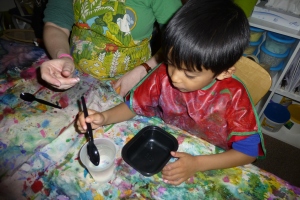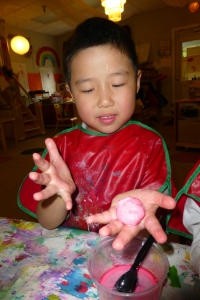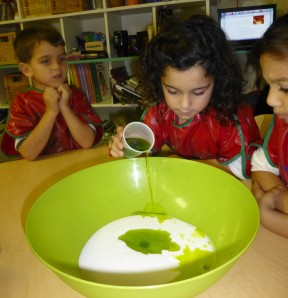 While hiking through the woods with Mr. Cooper the other day, the children came across some unknown tracks in the mud. With Mr. Cooper’s help, they deduced that they must have been made by wild turkeys. Returning to the classroom, we made a list of other kinds of tracks we might be able to find on our campus. These discussions prompted at least a week’s worth of group and individual activities.
While hiking through the woods with Mr. Cooper the other day, the children came across some unknown tracks in the mud. With Mr. Cooper’s help, they deduced that they must have been made by wild turkeys. Returning to the classroom, we made a list of other kinds of tracks we might be able to find on our campus. These discussions prompted at least a week’s worth of group and individual activities.
Using play dough and our collection of animal models, the children explored the variety of tracks that animals can make. Of course, once we started making animal tracks, cars, trucks, blocks, and cooking tools made tracks as well. We also discussed the idea that our plastic models may or may not be entirely accurate when making tracks.
Over in the math area, we examined scale copies of wild animal prints. The children used Unifix cubes to measure six different tracks. They used one-to-one correspondence when counting, non-standard units of measure when finding the length, and numeral recognition as they wrote the length found.

Once they completed the measuring portion of the project, the children practiced motor planning and understanding spacial relationships as they decided how to arrange their footprints so that all of them fit on their display.

Our final project invited the class to practice their skills as an illustrator. We created a book called, “Who was here?”. Each page had a different foot print and text matching the animal track (“A cat was here.”) with lots of white space for their animal portrait. While reading, we practiced using our “reading finger” to point at each word as we read and scanning from the left to the right. We also used the track images and beginning letter sounds to identify unknown words.
 Our sensory, or touch, table made its first appearance the other day. It is filled with colored beans. I actually prepped the table the first full week of school, but haven’t had the opportunity to introduce it to the class. In true Responsive Classroom style, we used guided discovery to find out more about the new materials. As you can see in the picture above, the class did an amazing job of following directions and listening with their whole bodies as I explained the basics of the bin. Here we are touching them for the first time:
Our sensory, or touch, table made its first appearance the other day. It is filled with colored beans. I actually prepped the table the first full week of school, but haven’t had the opportunity to introduce it to the class. In true Responsive Classroom style, we used guided discovery to find out more about the new materials. As you can see in the picture above, the class did an amazing job of following directions and listening with their whole bodies as I explained the basics of the bin. Here we are touching them for the first time:








 While hiking through the woods with Mr. Cooper the other day, the children came across some unknown tracks in the mud. With Mr. Cooper’s help, they deduced that they must have been made by wild turkeys. Returning to the classroom, we made a list of other kinds of tracks we might be able to find on our campus. These discussions prompted at least a week’s worth of group and individual activities.
While hiking through the woods with Mr. Cooper the other day, the children came across some unknown tracks in the mud. With Mr. Cooper’s help, they deduced that they must have been made by wild turkeys. Returning to the classroom, we made a list of other kinds of tracks we might be able to find on our campus. These discussions prompted at least a week’s worth of group and individual activities.

 We had a shoe extravaganza this afternoon! We each took off one shoe and tossed it into a giant shoe pile. The children then helped me figure out what kinds of shoes we had. We made a list of the different types on a large sheet of paper and sorted them into the appropriate groups. Then, we realized that there were other ways to sort them as well. We sorted by color, by size, and by the presence of tongues.
We had a shoe extravaganza this afternoon! We each took off one shoe and tossed it into a giant shoe pile. The children then helped me figure out what kinds of shoes we had. We made a list of the different types on a large sheet of paper and sorted them into the appropriate groups. Then, we realized that there were other ways to sort them as well. We sorted by color, by size, and by the presence of tongues.